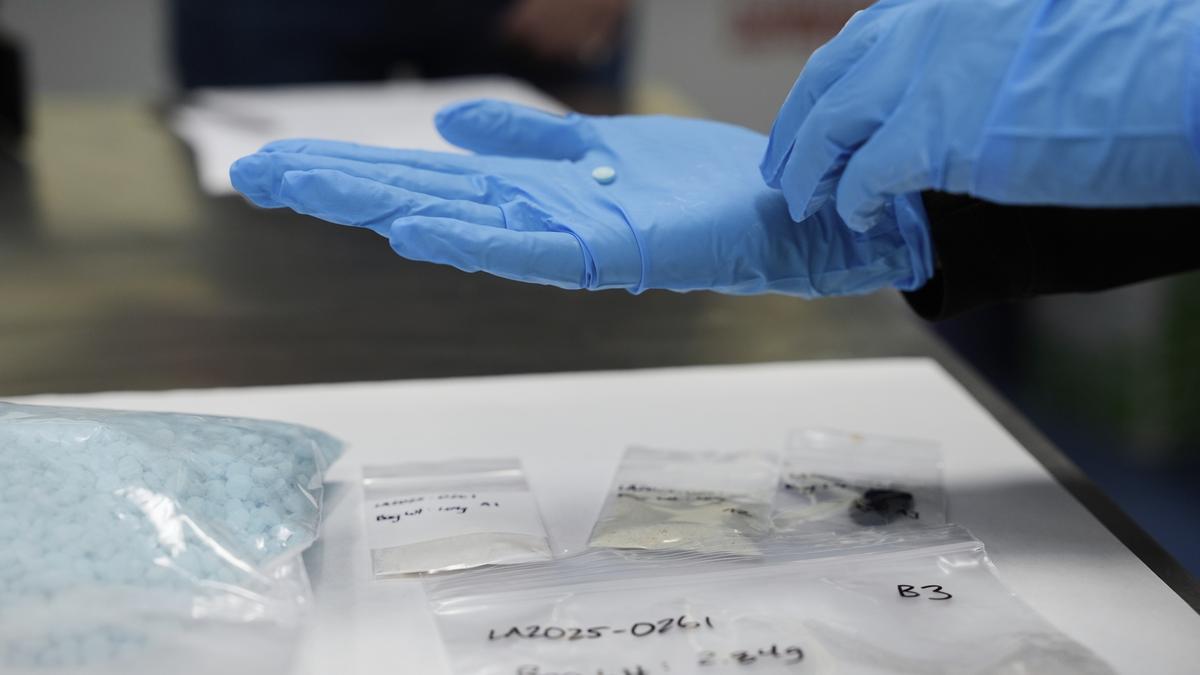The story so far: In the latest version of the Major’s List sent to the U.S. Congress, President Donald Trump listed 23 countries as being significant sources and/or sites of transit of illicit drugs — especially fentanyl — that he said threaten the U.S and its people. The list of countries includes India, Pakistan, China, and Afghanistan.
Also Read | Fentanyl: The opioid behind Trump’s tariff threats
What is the Major’s List?
The Major’s List is compiled every year to highlight regions where geography, commerce and/or industry contribute to the flow of narcotics or their precursor chemicals into international markets. The U.S. State Department has said that a country’s presence on the list doesn’t necessarily reflect the strength of its counternarcotics efforts but that the designation is based on whether drugs or the chemicals used to make them are being produced or transported through that country in important quantities. This said, Afghanistan, Bolivia, Myanmar, Colombia, and Venezuela were described as having “failed demonstrably” to meet their obligations under international drug-control agreements.
What is fentanyl?
Fentanyl is a synthetic opioid and the leading cause of overdose drug deaths in the U.S. It was first developed for medical use in the 1960s and is prescribed in controlled and regulated doses for patients in extreme pain. In illicit settings, however, fentanyl is about 50-times more potent than heroin. Just 2 mg can be fatal because it’s an agonist of the mu-opioid receptor, a protein on nerve cells that normally responds to the body’s own pain-modulating molecules. When fentanyl binds these receptors in sufficiently high quantities, it depresses the brainstem respiratory centres that control automatic breathing and crosses the blood-brain barrier and becomes highly concentrated in the central nervous system. Ultimately, the body suffers hypoventilation and respiratory depression.
Opioid overdoses are reversed by naloxone, a competitive mu-opioid receptor antagonist that displaces opioids from the receptor and restores normal breathing. However, it needs to be administered quickly because untreated respiratory failure can lead to brain injury and death within minutes.
According to U.S. data, from August 2023 to August 2024, more than 57,000 Americans died of opioid overdose, most of them involving fentanyl. The U.S. Drug Enforcement Administration (DEA) reported in 2022 that it seized 50.6 million fentanyl-laced pills and enough powdered fentanyl to account for 379 million potentially deadly doses, an amount sufficient to kill the entire U.S. population.
Why is fentanyl hard to regulate?
While heroin or cocaine are derived from plants, fentanyl is made in laboratories using compounds called its precursors. The most important of these are N-phenethyl-4-piperidone (NPP) and 4-anilino-N-phenethylpiperidine (4-ANPP). These substances have legitimate industrial and pharmaceutical uses but they can also be diverted to illicit supply chains.
In a counterfeit laboratory, the precursors are processed into fentanyl powder by chemical reactions common in organic chemistry. First, NPP is converted into 4-ANPP in a reductive amination reaction, where a nitrogen-bearing fragment is attached to the NPP ring and stabilised by a mild reducing agent. Then, 4-ANPP undergoes an acylation reaction where an acyl group (R–C(=O)) is attached to the nitrogen atom, yielding fentanyl. These reactions can be carried out with ordinary glassware, solvents, and moderate amounts of heat. As a result, once traffickers obtain the precursor compounds, they can easily turn them into fentanyl. And because only very small amounts of precursors are required to make large quantities of fentanyl and these substances can be shipped discreetly, the trade has been difficult to regulate.
How is fentanyl supplied?
The international fentanyl supply chain involves multiple actors. China and India play significant roles in the production of precursor chemicals, some of which are diverted into illegal channels. Mexican cartels are central in processing these precursors into fentanyl powder. Once produced, the powder is pressed into counterfeit pills or mixed with other narcotics and smuggled into the U.S., especially through its southwest border with Mexico. In response, the U.S. government has pursued criminal prosecutions of companies and executives, trade penalties, diplomatic pressure, and enhanced law enforcement. In January 2025, two Indian companies, Raxuter Chemicals and Athos Chemicals, were charged with conspiring to export fentanyl precursors to the U.S. and Mexico. Bhavesh Lathiya, a senior executive at Raxuter Chemicals, was arrested in New York and charged with smuggling. Following these cases, the U.S. Embassy in New Delhi revoked and denied visas for certain business executives and their families associated with trafficking fentanyl precursors.
In February 2025, the Trump administration imposed tariffs of 25% on Canadian and Mexican imports and an additional 10% on Chinese imports citing fentanyl trafficking as one of the motivations. While the tariffs on Canada and Mexico were suspended after those governments agreed to strengthen border enforcement, tariffs on China came into force.
Domestically, the DEA has intensified operations to seize fentanyl shipments, dismantle trafficking networks, and intercept counterfeit pills that resemble legitimate drugs, such as oxycodone. In parallel, naloxone is being distributed more widely while awareness campaigns have warned consumers that counterfeit pills may contain lethal amounts of fentanyl. Treatment programmes for opioid dependence are being reinforced to reduce demand and provide alternatives to those struggling with addiction.
Published – September 21, 2025 02:20 am IST
